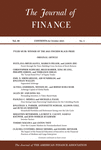-
作者:David, Alexander
作者单位:University of Calgary
摘要:Agents with heterogeneous beliefs about fundamental growth do not share risks perfectly but instead speculate with each other on the relative accuracy of their models' predictions. They face the risk that market prices move more in line with the trading models of competing agents than with their own. Less risk-averse agents speculate more aggressively and demand higher risk premiums. My calibrated model generates countercyclical consumption volatility, earnings forecast dispersion, and cross-s...
-
作者:Tookes, Heather E.
作者单位:Yale University
摘要:I present a simple model of informed trading in which asset values are derived from imperfectly competitive product markets and private information events occur at individual firms. The model predicts that informed traders may have incentives to make information-based trades in the stocks of competitors, especially when events occur at firms with large market shares. In the context of 759 earnings announcements, I use intraday transactions data to test the hypothesis that net order flow and re...
-
作者:Keswani, Aneel; Stolin, David
作者单位:City St Georges, University of London; Universite Federale Toulouse Midi-Pyrenees (ComUE); Universite de Toulouse; TBS Education
摘要:Gruber (1996) and Zheng (1999) report that investors channel money toward mutual funds that subsequently perform well. Sapp and Tiwari (2004) find that this smart money effect no longer holds after controlling for stock return momentum. While prior work uses quarterly U.S. data, we employ a British data set of monthly fund inflows and outflows differentiated between individual and institutional investors. We document a robust smart money effect in the United Kingdom. The effect is caused by bu...
-
作者:Morrison, Alan D.; Wilhelm, William J., Jr.
作者单位:University of Oxford; University of Virginia
摘要:In 1970 the New York Stock Exchange relaxed rules that prohibited the public incorporation of member firms. Investment banking concerns went public in waves, with Goldman Sachs the last of the bulge bracket banks to float. We explain the pattern of investment bank flotations. We argue that partnerships foster the formation of human capital and we use technological advances that undermine the role of human capital to explain the partnership's going-public decision. We support our theory using a...


